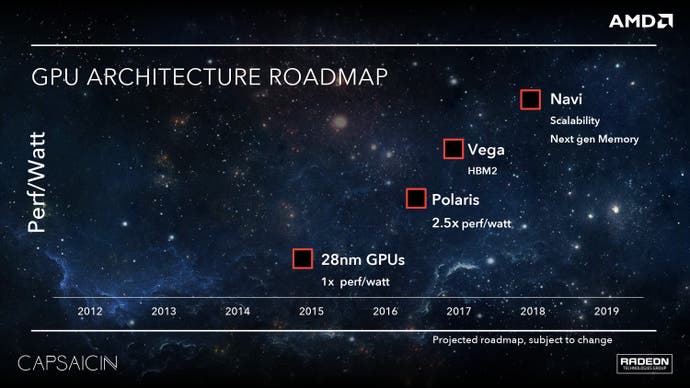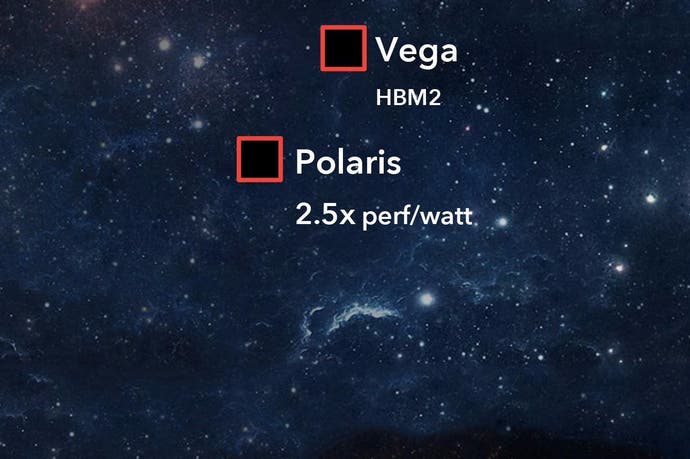In Theory: Can AMD Polaris regain the mainstream PC graphics market?
New leaks offer a clearer picture of prospective R9 470/R9 480 performance in the sub-£200 category.
The next generation of PC graphics technology is finally starting to gear up. There's innovation incoming from all angles, with the arrival of DirectX 12, plus mass production of new graphics cards using cutting-edge architectures paired with state-of-the-art production processes. We've already discussed the possibilities open to Nvidia, coming pretty close in predicting the technical make-up of the final products. Now it's time to turn our focus towards AMD: we know its new Polaris technology is arriving soon, and now we know what form the initial products will take. While Nvidia is aiming for the more affluent, top-end enthusiast with its initial offerings, AMD is targeting the more mainstream user instead.
AMD will release a series of Polaris-based graphics cards, but fundamentally, all of them are based on just two different hardware designs, dubbed Polaris 10 and Polaris 11. The former looks set to take the place of the R9 380 and 380X, while the latter almost certainly replaces the current 'value' cards - the R7 370 and maybe even the sub-£100 R7 360 too. Polaris 11 also forms the basis of AMD's gaming laptop strategy, the aim here being to provide console-level power for thin and light notebooks. Common to both is the use of 14nm FinFET transistor technology, offering a 2x increase in density compared to the 28nm process used in the existing GPU line-up.
The crucial factor here is that the R9 Fury line remains AMD's top-end product, with the firm instead focusing its new designs on the volume end of the market.
"The reason Polaris is a big deal, is because I believe we will be able to grow that TAM [total addressable market] significantly," AMD's Roy Taylor revealed in an Ars Technica inteview. "I don't think Nvidia is going to do anything to increase the TAM, because according to everything we've seen around Pascal, it's a high-end part. I don't know what the price is gonna be, but let's say it's as low as £500/$600 and as high as £800/$1000. That price range is not going to expand the TAM for VR. We're going on the record right now to say Polaris will expand the TAM. Full stop."
Taylor may well have been a little off in his assessment here (GTX 1070 is likely to be a £300 part, based on its $380 pricing) but you can see the point he's making here. AMD is looking to lower the cost of entry for systems based on the minimum VR spec requirements released by Oculus that - by and large - developers have stuck to in the first wave of games. That would be the Radeon R9 290 and the GeForce GTX 970. It's a good choice, forming the existing sweet spot in terms of power vs performance. The Nvidia card alone enjoys almost five per cent of the enthusiast gaming market, according to the March 2016 Steam Hardware Survey. That's a phenomenal result, bearing in mind the vast range of graphics hardware on the market. And as things stand right now, AMD's competitor in this segment - the R9 390 - may well be the better card. In theory, its successor could offer the same ballpark performance, and may indeed eclipse it, depending on how hard AMD pushes.
So how does the spec stack up? What we know so far is that one possible version of the Polaris 10 features 2304 shaders - or 36 compute units - paired with a 256-bit memory bus and GDDR5 memory. As you can see from the spec comparison with the AMD's existing 28nm parts below, the evidence suggests both a computational deficit and a reduction in memory bandwidth compared to where AMD needs to be, assuming it's targeting R9 390-level performance. However, this does not factor in the efficiency improvements made to the GCN architecture and a potential increases in clock-speed, which may well make up the balance.
The Polaris 10 specs we have come from what must be a preview sample. Device IDs for a selection of Polaris processors were lifted from a Linux kernel submission and from there, a simple Google search brings up a SiSoft benchmark, along with some GFXBench OpenGL test results. Now what's curious here is the clock-speed of the Polaris 10 part - just 800MHz. This may well be a lower-clocked sample. PlayStation Neo - almost certainly using Polaris 10 - has a GPU clocked at 911MHz, while yesterday's GTX 1080 demo showing the GPU overclocked to 2.1GHz has radically reshaped expectations of speeds achievable by FinFET products.
There are two possibilities here - a pre-production part with lower clocks, or perhaps a more power-efficient variant - maybe even a test run for a higher-end laptop processor. Regardless, the results fall short of R9 390 specs, but another leak - showing Polaris 10 at 1050MHz - well, that might well make up the shortfall. Indeed, in the wake of the Pascal reveal, even 1050MHz looks highly conservative. And of course, we must remember that neither of these benchmarks count for much up against actual gaming performance.
There's another possibility too - that this is a prospective R9 480 with deactivated compute units, with the notion that a R9 480X is also in the pipeline, with a full complement of 40 CUs - the same as the R9 390. Remember that both AMD and Nvidia produce multiple GPUs from the same core processor, deactivating areas of the chip with defects in the silicon. Assuming that the new chips offer R9 390 performance or better at an R9 380 or 380X price-point or lower, that's a potent combination - though the concept of value in the GPU market may well be redefined, assuming that Nvidia does indeed provide Titan X levels of performance with its $380 GTX 1070.

| Polaris 10 | Tonga/Antigua | Hawaii/Grenada | |
|---|---|---|---|
| Products | Possible 480/480X | R9 285/380/380X | R9 290/290X/390/390X |
| Compute Units | 36 (Possible 40 for '480X') | 28/32 (380X) | 40/44 (290/290X) |
| RAM | 4GB GDDR5 | 2GB/4GB GDDR5 | 2GB/4GB/8GB GDDR5 |
| Memory Interface | 256-bit | 256-bit | 512-bit |
| Process | 14nmFinFET | 28nm Planar | 28nm Planar |
And we now know more about Polaris 11 too. The nomenclature may suggest a more powerful chip than Polaris 10, but GFXBench test results in concert with a Compubench leak confirm that it is actually a replacement for the classic 'Pitcairn' design that powered Radeons as diverse as the HD 7850, HD 7870, R9 270, R7 265, R9 270X, R9 370 - and PlayStation 4, of course. The Compubench leak tells us that one iteration of Polaris 11 features 1024 shaders, or 16 compute units - exactly the same as the Radeon HD 7850/R7 265/R9 370. Doubtless there will be a fully enabled 20 CU version too. As well as a lower-end desktop card (let's hope for a sub-£100 price-point on the 16 CU version), Polaris 11 is AMD's attempt to reclaim some of the gaming notebook market, by offering console-level performance for thin and light laptops.
The benchmark leaks tell us very little about the actual performance of Polaris 11, but AMD itself has said that a Polaris chip - almost certainly 11 - offers a 61 per cent reduction in power consumption running Star Wars Battlefront at 1080p60 on medium settings, requiring 84W vs Nvidia's 140W. There are a lot of nit-picks we have with that comparison - the game just performs better on AMD hardware and the 950 is a cut-down 960, so not operating at peak efficiency. However, it shows the red team's focus on getting power consumption down. 1080p60 at medium should offer equivalent performance to 900p on high - which is pretty much where the PlayStation 4 version of Battlefront operates.
Polaris may well look like something of a disappointment for those wanting the red team to reclaim its mantle as the creator of the world's fastest GPUs and in the wake of the radical Pascal reveal, the question is to what extent the latest iteration of the GCN architecture offers in terms of a performance bump over its last-gen counterpart. However, our take is that it's a good strategy - though perhaps not for the reasons AMD has publicly stated. Roy Taylor talks about VR as a focus, but the same power level has more practical applications: specifically the ability to match or exceed console visual quality while at the same time handing in 1080p60 performance or better. Going back to AMD's Battlefront example, assuming that Polaris 10 hands in R9 390 levels of performance, it should provide 1080p60 performance on ultra settings with an enormous power efficiency improvement, compared to the existing Hawaii/Grenada-based cards.

| Polaris 11 | Bonaire | Pitcairn | |
|---|---|---|---|
| Products | Possible 460/470/470X | HD 7790/260/ 260X/360 | HD 7850/7870/R9 265/270/270X/370 |
| Compute Units | 16 (Possible 20 for '470X') | 12/14 (260X) | 16/20 (7870/270X) |
| RAM | 2GB GDDR5 | 1GB/2GB GDDR5 | 2GB/4GB GDDR5 |
| Memory Interface | 128-bit | 128-bit | 256-bit |
| Process | 14nmFinFET | 28nm Planar | 28nm Planar |
So quite why AMD is making a value play for VR is somewhat puzzling when the reality is that it is a platform requiring a £500 investment in the headset. However, the end result is that R9 390 performance for R9 380 money looks like a good deal, and if AMD can get close to the insane clock speeds seen in Pascal, Polaris 10 could actually be a highly potent part. And it's an area of the market that AMD could corner in the short term, assuming that Nvidia doesn't launch against them - this is far from an impossibility.
So where does that leave the high-end 'halo' products? For now, the R9 Fury products remain the flagship - though we suspect there may well be some heavy discounting once GTX 1080/1070 ship. What we do know is that AMD looks set to replace the Fury X some time in 2017 with a new product, codenamed Vega, which pairs a new processor design with HBM2 memory. Thanks to a rather unfortunate LinkedIn leak from an AMD engineer, we know that Vega features 4096 shaders (64 compute units) - just like the Fury X.
It's an interesting piece of information. AMD is either banking on architectural improvements to make it competitive, or else it's simply a smaller, cheaper chip - and more of a replacement for the existing R9 390 or 390X in terms of price-point positioning. There's also the chance that it may well be more highly clocked too: the clocks we've seen in all the leaks so far are way slower than what we've seen with Nvidia's Pascal offerings and we should expect some movement here. After all, the speed bump seen in PlayStation Neo (911MHz, up from PS4's 800MHz) suggests that AMD's 14nm FinFET can run faster than its 28nm processors.
In closing, the move to FinFET transistor technology opens up a wealth of opportunities. Whether by chance or by design, AMD is targeting an entirely different market to Nvidia for its initial FinFET products. In terms of whether the red team can reclaim leadership, or even a substantial share of the mainstream sector of the market, it all comes down to when Nvidia plans to unleash its equivalent parts. Barring unexpected surprises, AMD's roadmap confirms that the firm is giving Nvidia a clean run through 2016 at the top-end of the market. Will Nvidia reciprocate in the mainstream segment? And to what extent does market-leading performance matter in the mainstream market compared to the power of the brand? Take a look at the second-most popular discrete GPU in the Steam Hardware Survey - it's the GTX 960, not the cheaper, significantly more capable R9 380...


